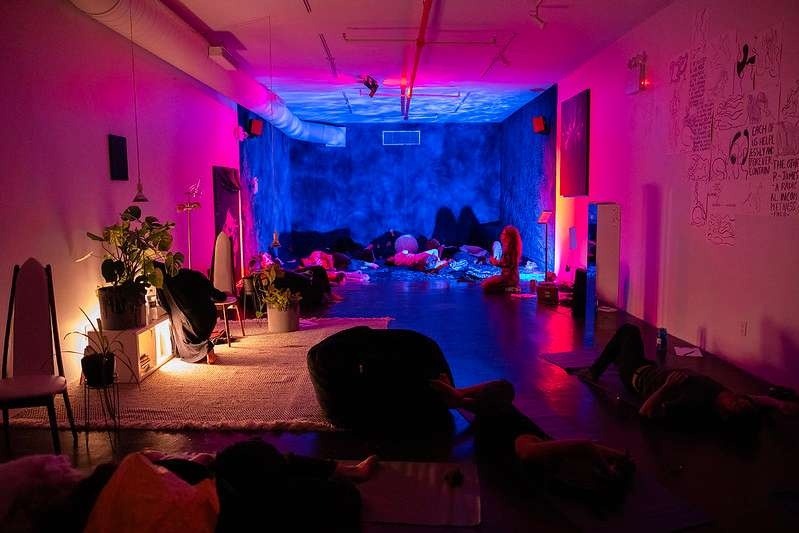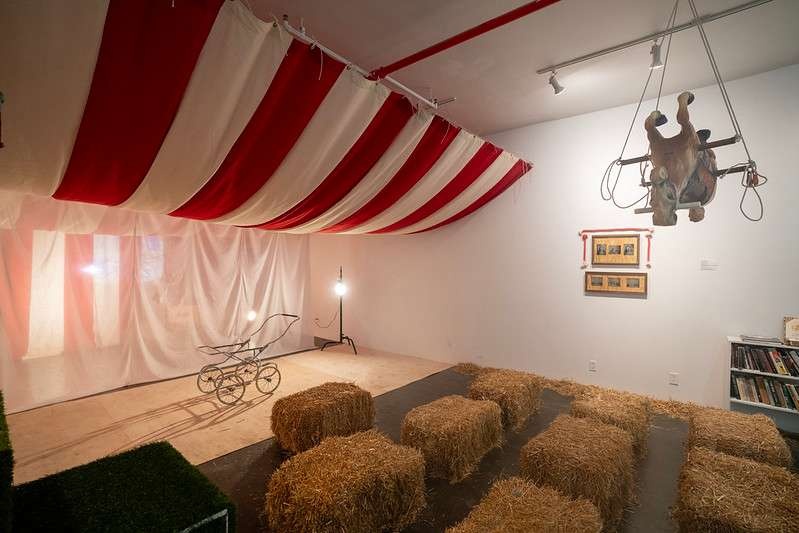“Cameras gave to black folks, irrespective of class, a means by which we could participate fully in the production of images. Hence it is essential that any theoretical discussion of the relationship of black life to the visual, to art making, make photography central. Access and mass appeal have historically made a powerful location for the construction of an oppositional black aesthetic…the camera became in black life a political instrument, a way to resist misrepresentation as well as a means by which alternative images could be produced…The camera allowed black folks to combine image making, resistance struggle, and pleasure.”
-bell hooks, “In Our Glory: Photography and Black Life,” Art on My Mind: Visual Politics
Aesthetic pleasure, euphoria, humor, healing, and seduction are tools for narrative disruption in Rashayla Marie Brown and Jamila Raegan’s latest site-specific installation at Recess Art in Clinton Hill, Brooklyn.
At the entrance to the exhibition, viewers are greeted with reflective double doors adorned with a golden arch of vinyl text and repurposed quotes from canonical films in Black cinema including The Color Purple and Shaft. The gold text is complemented with a backdrop of Hollywood’s signature red curtain, which is strategically used to block outside light from entering the space. This obstruction of natural light allows for the interior of the installation Motion Picture Association for Maintaining Personal Ambivalence (MPA for MPA) to exist as an immersive ruby universe.
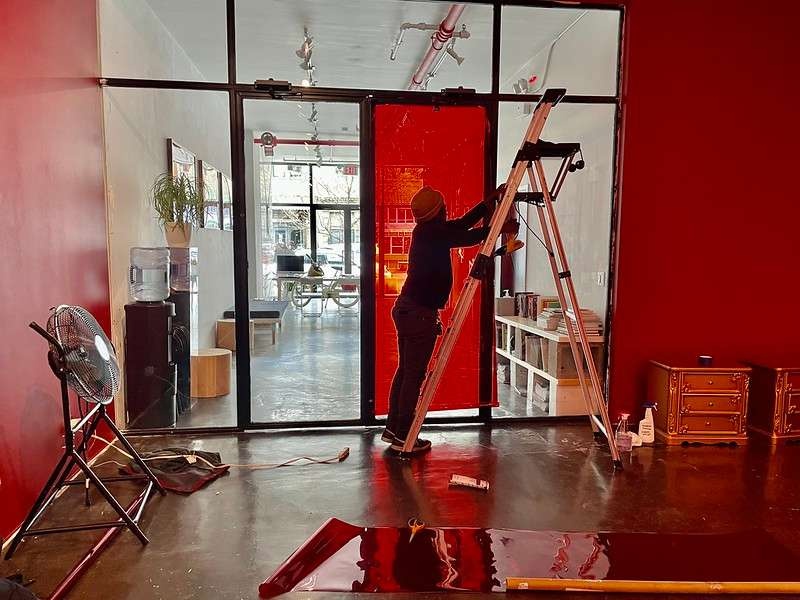

All gallery lighting is replaced with red light bulbs allowing the color red to wash over the entirety of the room and the objects within it. A series of altars and red velvet carpets engage audience members in a procession down the center of the room leading up to two flanking mesh curtains draped from the ceiling. The assortment of objects surrounding these curtains, such as gold plated chairs, plush pillows, perfume bottles, reflective surfaces, wooden cabinets, and plant-life construct an environment that invites viewers to subconsciously relax the body and mind and enter a state of bliss. “Jamila’s work, in addition to making installations that are beautiful, is also interested in practical application. She understood that the color red would physically do something to people immersed in the space. Red light is meant to subdue and calm people through immersive light therapy.” This collection of opulent material reminiscent of a matriarchal domestic interior — or what Brown and Raegan deem as Black femme aesthetics — is meant to center the pleasure and dignity of Black life.
“Working with the color red has multiple signifiers for me,” Brown says. “I’ve been exploring the color for close to 11 years and every time I work with red, it expands. When I first started exploring the color red, I was thinking about the way light-skinned Black women in the South are called red, as in ‘red-bone.’” She goes on to explain how such Black vernacular traditions are connected to the symbolism of the red carpet within the entertainment industry, which exalts people who reflect mainstream beauty standards. For Brown, “the red carpet is a gesture of exalting the people I put on it.” While the color red grounds the exhibition’s exaltations of Black women, it is “really about the root chakra, and representing the idea of stability and security.” says Brown.
Brown and Raegan therefore incorporate an array of signifiers related to the hue of red in popular consciousness to grip the viewer— from the root chakra, to the red carpet, to redbone. Designed with post-traumatic stress disorder survivors in mind, MPA for MPA transforms the Recess gallery space into a platform for healing, empowerment, respite, and creative production.
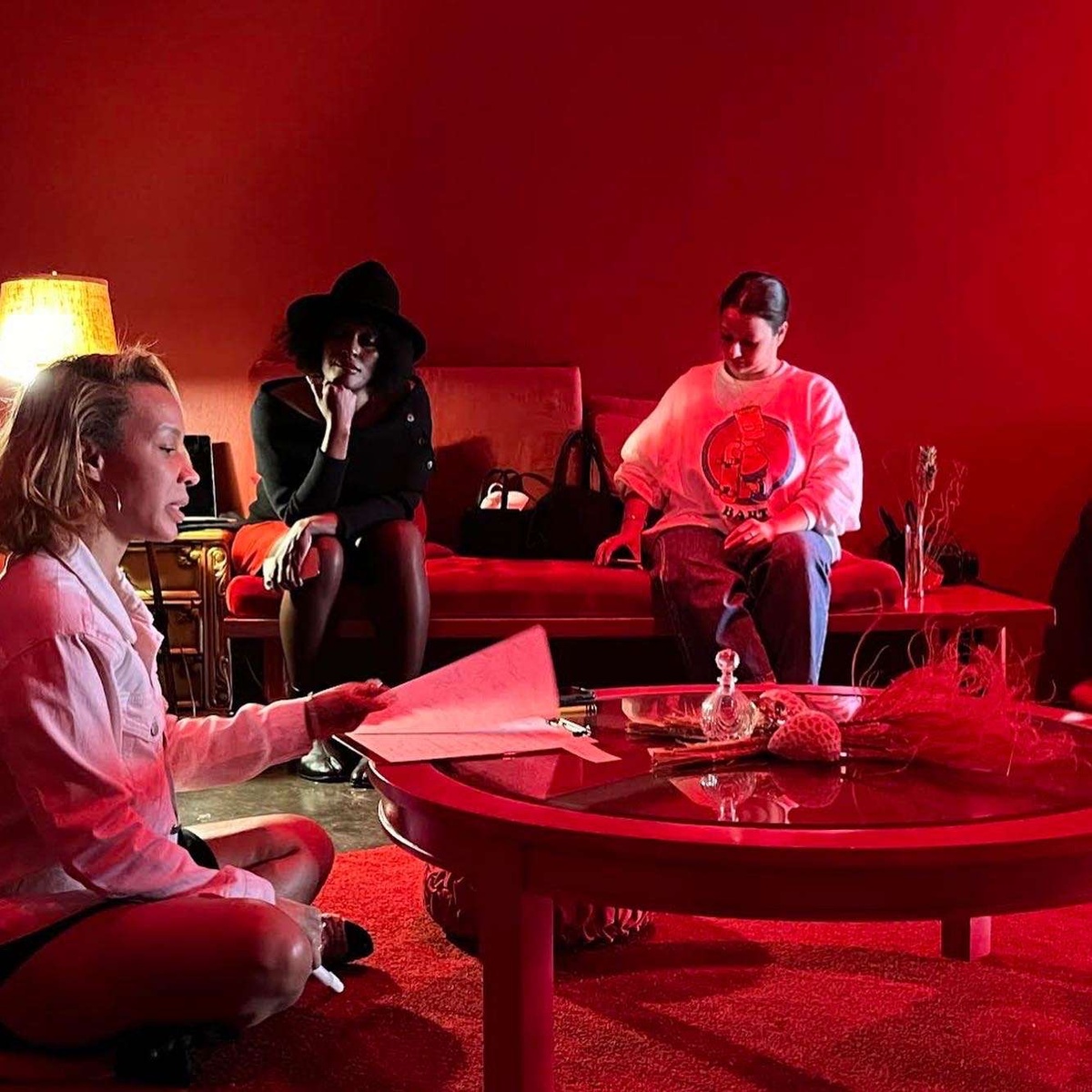

Rashayla leads a co-writing session alongside media-maker Ryah Aqel
The concept for the exhibition project was inspired by Black performers such as Josephine Baker, La Lupe, Dorothy Dandridge, Ma Rainey, Billie Holiday, Eartha Kitt and more—women whose successes and artistic roles were often pre-determined by the limits of the film industry and the era they worked within. MPA for MPA thus contends with the politics of protecting images centered on Black experiences and the power of Black-owned media. Through public programming, MPA for MPA invites visitors to discuss characters in movies such as Foxy Brown and the persona of the “Angry Black Woman” who is in conflict with the majority of characters around her; the concept of “damsel in distress” in movies such as Black Orpheus and the film’s idyllic portrayals of Black favelas; the “mammy” figure in the movie Imitation of Life; and many more stereotypical tropes that are projected onto Black characters in popular culture. Through intentional creative gestures, Brown and Raegan’s installation serves multiple interactive functions: a healing room, 1950’s writer’s room, a photographic darkroom, and an independent filmmaking studio space. Every week, Brown and Raegan hosted guest facilitators for public programs engaging the community in concepts related to the exhibition. This included co-facilitated workshops with local women of color media-makers Ryah Aqel and Chanelle Aponte Pearson and photography sessions led by artists Shala Miller aka Freddie June and Tiffany Smith. Facilitators hosted public lectures, live cinematic ideation conversations, hand-drawn storyboarding, and photography sessions that invited participants to rewrite oppressive narrative tropes and plotlines commonly found in the mainstream film and television industry.
Audience members, along with local filmmakers, activists, and artists, also convened to discuss celebrated movies and shows that focus on an exploited Black character, including Euphoria, Moonlight, and Scandal. Following an analysis of a chosen film or show, Brown and Raegan then invited the public to explore alternate storylines in an effort to give voice to people who are left out of the pre-production filmmaking process: the viewers. After analyzing the narrative arc and revising endings in a way that allows the central characters to feel empowered, audience members re-enact the narrative of their imagination through a staged photograph with curated props.
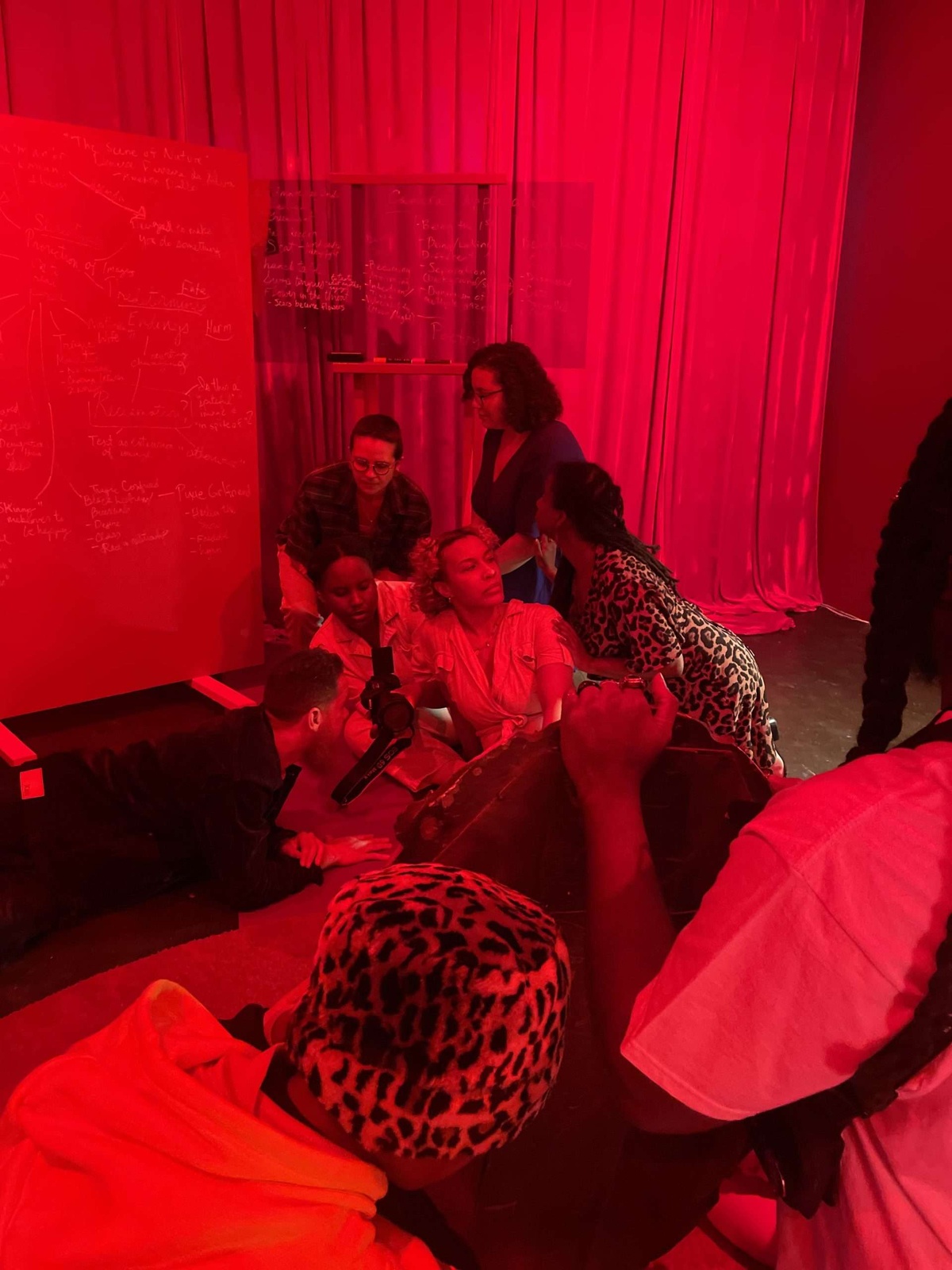

A photography session lead by media-maker Freddie June
At the intersection of public performance, filmmaking, and photography, MPA for MPA negotiates personal and collective narratives related to the Black experience through an immersive exhibition designed for healing, co-creation, and community building. By constructing sensory environments that envision utopian and dystopian worlds, Brown and Raegan question mainstream representations of the traumas that historically impact Diasporic people with the ultimate goal of constructing intimate visions of joy and comfort.
About the artist
Sabrina Greig
Sabrina Greig is a Haitian-American museum professional, writer, and arts administrator from New York City. She received her MA in Art History from the School of the Art Institute of Chicago with a focus on representations of the Black diaspora in popular culture, contemporary art, and architectural history.
Explore/Archive
See allDecember 2025
The INSTITUTE FOR TRANSHUMANIST CEPHALOPOD EVOLUTION and Learning from Octopuses
Barbara London
Barbara London reflect's of Miriam SImun's INSTITUTE FOR TRANSHUMANIST CEPHALOPOD EVOLUTION
October 2025
streamlined reflections, courtesy of noise canceling headphones
Gabrielle Rucker
Gabrielle Rucker reflects on the radical intimacy and auditory life at the heart of Deli Radio
July 2025
Tell My Jockey: CUNTRY’s Discourse From the Horse’s Mouth
Ericka Pérez
Assembly fellow Ericka Pérez reflects on clowning, resistance, and CUNTRY’s radical refusal to perform.
